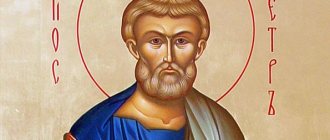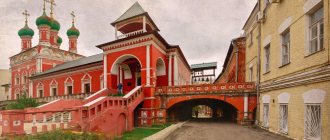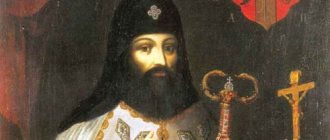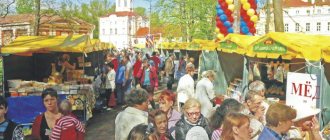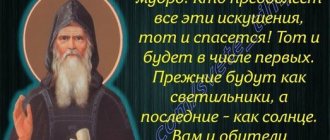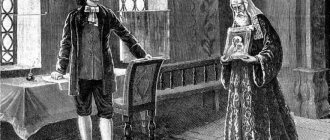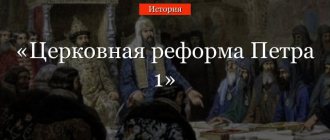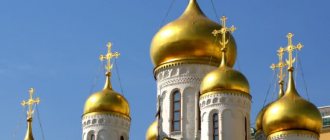Memorial Day: December 31 (January 13)
The future Saint Peter (Mogila) was born on December 21, 1596 in Suceava, the third son in the pious family of high-born Moldavian boyars Mogila (in modern Romanian transcription - Movila), who at that time occupied the royal thrones of the Danube principalities. At baptism he was named in honor of St. Peter of Moscow, as he was born on the day of his memory. His father Simeon Mogila was the ruler of Wallachia in 1600–1602, and from 1606 until his death in 1607, the ruler of Moldavia. In 1612, the Graves, after their defeat by Cantemir Murza, who took over the reign, had to flee to Poland, where they had strong and wealthy relatives.
He received his education at the Lviv fraternal school in a strictly Orthodox spirit, hostile to the union. He continued his education by traveling abroad, where he attended lectures at various universities - in particular, he took a course in verbal science and theology at the University of Paris.
He served in the Polish troops and distinguished himself in the battle of Khotyn. However, probably under the influence of the Kyiv Metropolitan Job (Boretsky), he decided to leave military service and take holy orders. Around 1624, he entered the Kiev Pechersk Lavra to share the fate of the Orthodox monks persecuted by the Polish authorities. At that time, many highly educated and active monks gathered here, the translation of patristic books, the compilation and publication of works in defense of Orthodoxy were underway. In such an environment he completed his education.
With the blessing of Metropolitan Job and Archimandrite Lavra Zacharias (Kopystensky), at his own expense he sent several capable young people abroad to improve in the sciences.
In 1627, after the death of Archimandrite Zacharias, at the insistence of the learned monks, he was elected archimandrite of the Lavra. Through his care, the Church of the Assumption of the Mother of God was renovated, the holy caves were decorated, the ancient Hermitage-Nicholas Monastery was returned under the control of the Lavra, the Goloseevskaya Hermitage was founded, and an almshouse was established at his expense.
Under his leadership, the condemnation of the “Apology” of Meletius (Smotrytsky) took place in 1628.
Being nominally subordinate directly to the Patriarch of Constantinople as a stauropegial “great archimandrite,” he was not subject to the Metropolitan of Kyiv. Peter was close to Metropolitan Job (Boretsky) - the latter, dying, left his library to Peter and appointed him executor. But with his successor, Metropolitan Isaiah (Kopinsky), Peter developed a less trusting relationship - according to some historians, hostile. This opposition may have been the reason why Peter took up the founding of a new Orthodox educational center in Kyiv, despite the already existing Kiev fraternal school.
Archimandrite Peter put a lot of effort into the founding of a new higher theological school at the Lavra - the first of its kind in the East Slavic lands. Upon the return of the young men sent abroad, he appointed them as teachers, and also took scientists from the Lvov brotherhood. He organized the first hostel for poor students in the Lavra, giving several villages from his estate and Lavra volosts to support the school. A new school “for the teaching of the liberal sciences in Greek, Slavic and Latin” opened in 1631. Soon, when the Kyiv brothers recognized him as the guardian and guardian of their school and subordinated it exclusively to the authority of the Patriarch of Constantinople, Peter united his Lavra school with the brotherly one. This work was blessed by Patriarch Kirill (Lukar) of Constantinople, Metropolitan Isaiah (Kopinsky-Borisovich) of Kiev, and approved in writing by Orthodox bishops and the most distinguished clergy and the Lavra brotherhood.
By that time, the Polish heir to the throne, Prince Vladislav, showed himself ready to give the Orthodox the right to legal existence, having developed a corresponding bill in the Sejm commission. Archimandrite Peter, who was then in Warsaw, wrote from there to all Russians, so that they would not agree to accept the conditions set out in the draft, and convinced them to use the elected Diet to achieve full satisfaction of the demands. When the Sejm came, at which Vladislav was elected king on November 8, 1632, new conditions for the legalization of Orthodoxy were adopted, according to which, for the first time after the conclusion of the Union of Brest in the Polish-Lithuanian Commonwealth, the existence of the Orthodox Kyiv Metropolis and four dioceses was solemnly recognized at the state level. One of the conditions for the legalization of the Orthodox Church was the dismissal of many previously elected bishops and the election of new ones. At the same time, at the Sejm, Metropolitan Isaiah was declared defrocked and the Orthodox delegates elected Peter (Mogila) as the new metropolitan, retaining the Lavra archimandriteship for him. This was done in the context of a new war with the Moscow state, in which Vladislav needed the support of the Orthodox Russian population of the Polish-Lithuanian Commonwealth, and the former Orthodox hierarchy, which had suffered the hardships of persecution against Orthodoxy in the Polish-Lithuanian Commonwealth, leaned towards the side of the Russian Orthodox Church and Moscow. In addition, Archimandrite Peter pointed out to the Orthodox delegates of the Sejm that the fight against the Uniates was now just flaring up, and the decrepit Metropolitan Isaiah would not be able to wage it energetically enough.
Immediately at the Sejm, already as an elected metropolitan, Peter began to petition for the transformation of the Fraternal Epiphany School he had established into an academy. The Roman Catholic and Uniate clergy, as well as some of the noblest members of the Diet, strongly opposed this. But the king did not dare to antagonize the Orthodox and, at the persistent request of Peter, gave him the privilege, where, instead of an academy, the school was called a college with an extensive course in theology and philosophy.
The removal of Metropolitan Isaiah was legalized by the church by the fact that the Patriarch of Constantinople Kirill (Lukar) sent the elected Bishop Peter an archpastoral blessing for the metropolis. However, among the Orthodox there were also supporters of the removed Metropolitan Isaiah, who blamed Peter for personal ambition. Therefore, Peter arranged his consecration not in Kyiv, but in Lvov. Here, on St. Thomas Week, April 28, 1633, he was consecrated bishop with the elevation to the rank of Metropolitan of Kyiv and Galicia, and the former Metropolitan Isaiah was “degraded.” The ordination was led by the Lvov bishop, using the powers of the exarch of the Patriarch of Constantinople. Then the newly installed metropolitan went to Kyiv, where upon entering he was greeted with two famous panegyrics - from the Lavra brethren and the fraternal school. Upon entering Kyiv, he had to ban and depose the priests who stood for Isaiah, and forcibly transport the former metropolitan himself to the Lavra.
Upon his accession to the metropolitan throne, he began to organize the Kyiv Collegium, which invariably enjoyed his special attention and received the name Mogilyanskaya in his honor. She was completely settled and provided for, although she suffered oppression from the Kyiv governor. The Kiev-Mohyla College became the first higher educational institution in the East Slavic lands. In order to confront modern Roman Catholic scholarship on the same level, Metropolitan Peter borrowed the entire structure of the new school from Latin-Polish models, which he thus instilled in the South Russian Orthodox environment. Subsequently, the Metropolitan also opened a lower school in Vinnitsa.
He returned and restored a number of ancient Kyiv shrines. He returned the St. Sophia Cathedral and the Vydubitsky Monastery, previously captured by the Uniates. He restored and built the Church of the Savior on Berestovo and the Church of the Three Saints - he gave the latter to the Brotherly Master. In 1635, the remains of the Church of the Tithes were discovered and cleared of ruins, under the ruins of which the relics of Equal-to-the-Apostles Prince Vladimir were found. Metropolitan Peter planted a linden tree near the ruins that same year. Funds for the restoration of churches and monasteries came from the Lavra, from the metropolitan’s personal property, from donations from pious people, from grants from the Tsar of Moscow.
He paid great attention to the publication of church books, and demanded that no books be printed without comparing them with Greek originals. The Missal, the Colored Triodion and the Breviary with important instructions for clergy were significantly revised, expanded and published. Divine services under the Metropolitan began to be performed especially solemnly and splendidly. Metropolitan Peter actively introduced and restored Greek prayers and rites among the Slavic people. In his Trebnik, for example, the prayer of St. Sophronius of Jerusalem for the Great Blessing of Water was introduced; in his Lenten Triodion, for the first time in the Slavic world, a complete Synodik appeared on the Sunday of Orthodoxy - one of the most significant doctrinal documents of the Orthodox Church. However, at the same time, under Roman Catholic influence, a number of rites that were new to the Orthodox Church were introduced, the most notable of which were the Lenten passions in remembrance of the Passion of Christ and the reading introduced into the Trebnik. Wherein
Under Bishop Peter, Righteous Juliania, Princess Olshanskaya, was glorified. He made efforts to glorify the Pechersk saints throughout the church, and under him the Patericon of Pechersk was compiled.
Among the numerous theological works of Metropolitan Peter, a special place was occupied by the defense of the Orthodox against accusations of Protestantism and the expression of the correct teaching in catechetical form. The appearance in 1629 of the Calvinist “Confession of Faith” under the name of the Patriarch of Constantinople Cyril (Lukar) caused confusion in the Orthodox community, aggravated the polemics of Roman Catholics against Orthodoxy, and prompted Metropolitan Peter to respond. A special occasion was the denunciation of the writings of the apostate from Orthodoxy Cassian Sakovich, who accused Orthodoxy of adopting reformist opinions. In response to this libel, Metropolitan Peter took an active part in the compilation of the accusatory collection “Λίθος, or Stone,” as well as in the preparation of a religious treatise - the so-called. “Confessions of Peter Mogila” (see more details).
In 1640, Metropolitan Peter convened a Local Council in Kyiv, at which Sakovich’s work was refuted and, after some corrections, the prepared Orthodox confession of faith was adopted. At the Council of Iasi in 1642, this confession was further adjusted and sent for translation and verification to the Eastern patriarchs. In 1645, the Metropolitan published one of the editions of the “Confession” in Kyiv, after which a number of new editions appeared in different languages and became widely circulated as an important doctrinal document of the Orthodox Church.
Metropolitan Peter was fully fluent in Latin and Greek. He led a strictly ascetic life. He was in awe of the Kiev-Pechersk Lavra and considered it a place of the special presence of God.
Before his death, he bequeathed to the Kyiv College his library, real estate acquired for it and a significant amount of money, and ordered its mentors to live by his rules and commemorate him every Thursday. He bequeathed a lot to the Lavra and other monasteries and churches that he built from the ruins. He died on December 31, 1646, on the night of 1647. According to his will, he was buried in the crypt of the Great Assumption Church of the Kiev Pechersk Lavra, under the left choir in the middle part of the temple.
The body of Metropolitan Peter rested at the burial site until the Second World War. In November 1941, the Great Lavra Church was blown up, and the explosives were placed near the burial place of the saint. The coffin with the remains was completely destroyed; only silver plates with the family coat of arms and epitaph were preserved, which were found during excavations in 1982 by an archaeological expedition led by V. Kharlamov.
Origin and family
On December 21, 1596, a son, Petru, was born into the family of Moldavian boyars Movile; his name was given in honor of the Moscow Metropolitan Peter.
- 1596 is the year of the adoption of the Union of Brest, according to which the Western Ukrainian part of Orthodoxy came under the rule of the Roman Catholics.
- 1596 - the time of accession to the Moldavian throne of Simeon Movile or Mogila.
- Boyar Simeon, the father of the future Metropolitan of Kyiv, ruled Wallachia for seven years at the beginning of the 17th century, and then in 1607 became the ruler of Moldova.
- In 1612, Cantemir Murza conquered Moldova, the boyars of Movile fled to relatives in the Polish-Lithuanian Commonwealth, under the tutelage of Mikhail Vishnevetsky, the ruler of the left bank of Ukraine.
Saint Peter Mohyla
Peter graduated from the Lviv fraternal school, which taught the basics of Orthodoxy, and to continue his education he went abroad, visiting various universities, studied Latin, and as a result chose a military career.
He was a participant in the Battle of Khotyn between the Poles and Ottomans. For the handsome, rich man, warrior and intellectual, 1624 was a turning point. He renounces the world and becomes a resident of the Holy Dormition Kiev-Pechersk Lavra, where, together with the monks, he endures all the persecution from the Polish authorities.
Saint Peter Mogila
A few days before the Nativity of Christ (old style), on December 21, 1596, a boy was born into the pious family of Moldavian boyars Movile. Nadezhda of a famous family, the third son, who years later will be looked upon as a worthy heir to the Moldavian throne.
He was named Peter (Petru) - in honor of the Moscow Metropolitan Peter, since the birthday of the first coincided with the memorial day of the second. It is unlikely that anyone then suspected that the newly baptized baby himself would later become the Metropolitan of Kyiv.
It is very symbolic that the future saint was born in the tragic year 1596 for the Church. This year, the Union of Brest was adopted, according to which part of the Western Russian Orthodox Church in the territory under Polish rule fell away from the Mother Church and forcibly joined Roman Catholicism. And in the same year, the Movile family officially ascended to the Moldavian throne, which it was able to hold on, with interruptions, for not much more than 15 years.
There are two legends about how the Movile surname originated. According to one of them, preserved in Moldavian chronicles, the rise of the family name dates back to the 15th century - to the time of the reign of Stefan IV, whom his contemporaries and descendants called the Great, as the founder of the Moldavian principality. However, the great ruler was short in stature. During one of the battles with the Hungarians (according to another version with the Turks) in 1486, a horse was killed near Stefan. The warrior Herold Purig, who was next to his commander, gave him his horse and, kneeling down, said: “Allow me, sir, to serve you instead of the hill.” The Lord, with the help of Purig, jumped on his horse and answered: “From a hill I will make you a hill (in Moldavian Movile, Russian version - Mogila).” This is how, according to legend, the famous Moldavian surname arose.
* * *
It is not surprising that the personality of a prominent church figure of the first half of the 17th century, Metropolitan of Kyiv and Galicia St. Petra Mohyla has been attracting attention for three and a half centuries. His name is associated with the appearance of the landmark Catechism (“Orthodox Confession of Faith”) (1643, 1649, 1662, 1696), the Trebnik (1646) and the Service Book (1629, 1639), which were landmarks for Slavic Orthodoxy. The facsimile republication in several volumes of the Trebnik, carried out by the Kiev Pechersk Lavra in 1999, was not intended at all for medievalist historians and archaeographers, but for serving priests, which speaks of the true imperishability of the spiritual and literary work of Peter Mogila. The Kiev College founded by him, transformed at the beginning of the 18th century into the Kiev-Mohyla Academy (the first higher educational institution in the East Slavic lands!), made it possible to socially legalize Orthodoxy, introduce it into the pan-European cultural context, fight for it in the cultural language of their confessional opponents (Uniates and Catholics).
Saint Peter was in awe of the Kiev Pechersk Lavra. He considered it a chosen vessel of Divine grace, a place of the special presence of God, which, moreover, was under the special protection of the Queen of Heaven. The Lord was called its Great Archimandrite and fully justified this high title. Under him, the Lavra was not only landscaped externally and internally. With his blessing, all Divine services began to be performed especially solemnly and splendidly. A new tradition was also introduced - to celebrate the Passion every Lent, with the reading of the Gospel about the suffering of our Lord Jesus Christ and the Akathist to the Passion of Christ, which is fulfilled in the Church to this day.
And it is no coincidence that it was under Vladyka Peter that Juliania, Princess Olshanskaya, was glorified, whose relics now rest in the Near Caves of the Kiev-Pechersk Lavra. Subsequently, Saint Peter made an attempt to achieve church-wide glorification of the Council of the Kiev-Pechersk Saints, who until his time were revered only as locally revered Saints. His predecessor Zacharias Kopystensky arbitrarily included the names of some of them in the festive Menaion along with the names of the general Church Saints. But the Bishop wanted to achieve conciliar recognition of the Church of Constantinople.
When Peter Mogila became Metropolitan of Kyiv, a Canon was compiled (around 1643) by the Venerable Pechersk, the author of which is considered to be the hieromonk of Constantinople and Patriarchal Exarch the Greek Meletius Sirig. The canon existed in two versions - in Church Slavonic and Greek. It was first published in the Lavra edition of the Followed Psalter in 1643–1644. Later, the Saint commissioned the “Synaxarium” (“Messyatslov”) on Mount Athos by St. Simeon Metaphrastus, which contained brief Lives of the Saints and interpretations of the holidays. St. Peter wanted to translate it, supplement it with the Lives of the Russian and Pechersk Saints and publish it in Church Slavonic, but did not have time. This titanic work was subsequently carried out by a student of the Kiev-Mohyla Academy, St. Demetrius of Rostov.
Saint Peter Mogila
But Vladyka Peter’s “Handwritten Notes” is also a unique monument of church history and literature. “Carefully collecting information about the blessed phenomena in the Kiev-Pechersk monastery,” wrote S. Golubev, “Peter Mogila, with no less zeal, collected and entered into his book stories (and sometimes personal observations) in general about all the most remarkable miracles and events in the church Orthodox (South Russian, Moldovan-Vlachian and partly Greek), mainly paying attention to those of them that clearly showed the superiority of Orthodoxy over other faiths and, moreover, exposed the failure of the latter.”
The saint has an entry in his diary about an event that showed the lack of grace of the Uniate Church. Saint Peter recorded that one day, during a service performed by the Uniate Metropolitan Hypatius Potsey, wine, instead of being transformed into the Blood of Christ, turned into ordinary water.
Later, Vladyka entered into religious polemics and struggle with opponents of the fatherly faith and the Orthodox Church. He wrote and published several religious and polemical books, which took a long time to mature and bear. There is reason to assume that their appearance, as well as the creation of other works, was facilitated by the Goloseevsky solitude - a small monastery built by the Saint in the outskirts of Kiev, four years after his elevation to the rank of Archimandrite of the Pechersk (Goloseevskaya Hermitage).
However, the activities of Peter Mogila have always raised many questions and ambiguous interpretations: on the one hand, he socially legalized Orthodoxy in Ukraine and Belarus, on the other, many of his innovations are considered as a result of the influence of the Roman Catholic Church and Western culture. On the one hand, Peter Mogila, it seems, was ready to make concessions, but on the other hand, he was adamant in the field of preserving the Orthodox rite and developing church “infrastructure” (through his efforts the St. Sophia Cathedral in Kiev was rebuilt, many churches of the Kiev Pechersk Lavra were restored Tithe Church).
Moscow Metropolitan Macarius Bulgakov wrote in “History of the Russian Church”: “The name of Peter Mogila is one of the best decorations of our church history. He undoubtedly surpassed all the contemporary hierarchs of not only the Little Russian, but also the Great Russian Church and even the entire Eastern Church - he surpassed him in his enlightenment, and even more so in his love for enlightenment and his exploits for the benefit of enlightenment and the Church. For his Little Russian Church, he rendered the greatest service in that he defended before King Vladislav IV its most important rights, scolded by the Latins and Uniates, and courageously defended it throughout his entire archpastoral service; restored much in it that had previously been overthrown or destroyed by enemies and laid the foundation for a better order of things. He rendered a great service to the entire Russian Church by founding and providing for his college, which served as the first breeding ground and model for religious educational institutions in Russia. To the entire Orthodox Eastern Church - because he took care to compile the “Orthodox Confession”, accepted and approved by all its high priests and to this day remaining its symbolic book.”
* * *
For almost 300 years, the body of the Kyiv archpastor rested in the crypt under the left choir of the Assumption Cathedral. But during World War II, in November 1941, when Kyiv, the capital of Ukraine, was occupied by Nazi troops, the Great Lavra Church was blown up. The explosives were placed precisely near the burial place of Saint Peter, so the coffin with the remains of the Saint was completely destroyed. Only silver plates with the family coat of arms and epitaph remained, which were found during excavations in 1982 by an archaeological expedition led by V. Kharlamov. On the ruins of the Assumption Cathedral, archaeologists established the burial place of the Saint, determined what the coffin was made of and what the sarcophagus was lined with... How prophetic were the words of Metropolitan Lazar Baranovich: “The grave hid the grave from us!”
But his works remain! And near the ruins of the Tithe Church, blown up in Soviet times, the linden tree planted by St. Peter in 1635 is still growing (and blooming in its time!). Through the prayers of St. Peter, in 1993, the revival of his beloved skete began, the Goloseevskaya Hermitage, abolished and destroyed during Soviet times. And the first Liturgy was served there on the day of remembrance of the Holy Great Martyr John of Sochava (heavenly patron of the Movile family), in whose honor Vladyka Peter built the first church in Goloseevo.
And 55 years after the terrible explosion of the Assumption Cathedral, in December 1996, the Holy Synod of the Ukrainian Orthodox Church canonized Kyiv Metropolitan Peter Mohyla as a locally revered saint.
Taking Holy Orders
Personal communication with the Kyiv Metropolitan Job Boretsky influenced the further fate of Peter Mogila, who decided to devote his life to the Orthodox Church by taking holy orders.
Having been the archimandrite of the Kiev Pechersk Lavra since 1627, he is subordinate to the Patriarch of Constantinople and bears the title of great archimandrite. After the death of Vladyka Job, he is the executor of the entire spiritual inheritance of the Vladyka, including the richest library.
The new archbishop decided to found a new educational Orthodox center in Kyiv, which caused opposition from Isaiah Kopinsky, who defended the primacy of the Kyiv fraternal school. In 1632, the Polish king Sigismund III dies, Archbishop Mohyla is invited as part of a delegation from Kyiv to a meeting of the Sejm to elect a new king, Vladislav the Fourth.
Icon of Peter Mohyla, Metropolitan of Kyiv
Father Peter justified the mission entrusted to him, he managed to convince the new king to recognize the Orthodox dioceses and metropolises as legitimate, to stop all prohibitions and oppression against Orthodox believers, having received a diploma, according to which it was allowed:
- freely to profess the Orthodox faith;
- perform the Sacraments;
- carry out restoration of temples and build new churches;
- create fraternities;
- open schools and colleges;
- set up almshouses.
The Orthodox people and clergy received the right to elect a metropolitan, into whose jurisdiction all monasteries and churches were transferred.
Important! On November 1, 1632, thanks to the prince’s upbringing and the subtle diplomatic gift of Peter Mohyla, an official decree was issued approving the independence of Orthodoxy in Ukraine.
In 1633, the priest was ordained metropolitan, gathering around him all those who were not indifferent to the fate of Orthodoxy in Ukraine.
In 1635, with the blessing of Father Mogila, the restoration of the Tithe Church, the reorganization of the Kiev Pechersk Lavra school, and the construction of an educational institution in Vinnitsa began.
In 1634, a Moscow school was founded, where monks of the Kyiv Lavra taught. Thanks to the efforts of Metropolitan Peter Juliana, Princess Olshanskaya was glorified among the righteous; he made great efforts to perpetuate the names of the Pechersk saints in the created Patericon of Pechersk.
Read about Orthodox saints:
- Gregory Sinait
- Boniface of Tarsus
- Zacchaeus the Righteous
Death and veneration
On January 1, 1647, in the full bloom of his strength, Saint Mogila suddenly went to the Lord, was buried in the Kiev Pechersk Lavra, and on March 22, it was decided to transfer the remains of the saint to the Sophia monastery. For three months, the relics of the metropolitan remained incorrupt; the place of his burial became the Great Pechersk Cathedral Church, the place indicated in the will of the saint.
Metropolitan Peter Mohyla canonized as a Local Saint
In November 1941, Kyiv was captured by the Germans, who blew up the Great Lavra Church, and along with it the grave of the saint was blown up.
In 1982, during excavations, silver plates were found, but which depict the family coat of arms of the Movile family and the epitaph.
The Holy Fathers, the saints, through their life example, are the guides of the Orthodox Christians remaining on earth to Heaven. Reflecting on the events of today, you understand that history develops in turns, in each of which the hearts of people are the battlefield of the devil with the Creator.
On December 8, 2005, Patriarch of Moscow and All Rus' Alexy II blessed January 13 as a day of honoring the memory of St. Peter Mohyla, who stood up for the defense of Orthodoxy in the 17th century, when Orthodox Ukraine was squeezed by the Muslim Porte and the Catholic Polish-Lithuanian Commonwealth.
PETER MOGILA
Metropolitan Peter (Tomb). Unknown artist. 17th century National Kiev-Pechersk Historical and Cultural Reserve.
PETER MOGILA (Mold. Petru Movilă) [12/21/31/1596, Suceava (Moldavian Principality, now in Romania) – 1/1/1647, Kyiv], church leader of the Polish-Lithuanian Commonwealth, Metropolitan of Kiev, Galicia and All Rus' (from 1633).
From ancient mold. boyar family, son of Simeon Mogila, ruler of Wallachia (1600–01, 1601–02) and Moldova (1606–07). Having moved after the death of his father (1607) to the Polish-Lithuanian Commonwealth, P. M. studied at the Lviv Orthodox fraternal school and, possibly, also at the Zamoysk Academy (in Zamosc) or at one of the Jesuit colleges. Having entered the military. service (c. 1617), served at the court of his guardian, Hetman S. Zholkiewski, participated in the battles with the Ottomans near Tsetsora (1620), near Khotyn (1621).
He could have been ordained under the influence of Metropolitan. Kievsky Job (Boretsky), who appointed P.M. as his executor. Elected archimandrite (September 16, 1627) of the Kiev-Pechersk Monastery. (the future Kiev-Pechersk Lavra), according to some sources, even before taking monastic vows (1625 or 1627). At the Warsaw convocation Sejm (1632), convened after the death of the Polish. King Sigismund III, by the Orthodox gentry P.M. was elected Metropolitan of Kyiv (11/3/1632); received the privileges of the metropolis (March 1633) from the new king Vladislav IV, as well as the blessing and title of “Exarch of the Holy Apostolic See of Constantinople” (early April 1633) from the Patriarch of Constantinople Cyril Lucaris. He was ordained in Lvov (April 28, 1633) during the lifetime of the ruling Metropolitan. Kyiv Kopinsky Isaiah, whom P. M. temporarily imprisoned in the Kiev-Pechersk Monastery.
In church politics, P. M. relied on the support of the Orthodox gentry of the Polish-Lithuanian Commonwealth, while at the same time approving the actions of the gentry against the unrest of the Cossacks in Ukraine. Using the experience of the Roman Catholic. church, P.M. carried out large-scale reforms aimed at centralizing the management of the metropolis. The highest church court was created - the “consistory”, the decisions of which had to be approved by the metropolitan; P.M. are subordinated and previously relatively independent. Orthodox brotherhoods; measures were taken to prepare and educate the parish clergy, whose representatives annually gathered at church councils to resolve various issues. questions and report to P.M.; books were printed on the territory of the metropolitan area only after their approval by the metropolitan.
In 1631 P.M. created the Kiev-Pechersk monastery. a school modeled on the Jesuit colleges. On Sept. In 1632 it was merged with the Greek-Slavic fraternal school that had been operating in Kyiv since 1615. profile. Since 1633, the united school began to be called the Kiev-Mohyla College (see Kiev-Mohyla Academy); P.M. opened its branches in Vinnitsa (1638) and Iasi (1640). P. M. founded a school at the Orthodox brotherhood in Kremenets (1636), paid for the education abroad of a number of clergy - future teachers of the college. In 1640 he asked Tsar Mikhail Fedorovich to open a monastery in Moscow for Kyiv monks who would teach slavs there. and Greek diploma In 1646 P.M. bequeathed his library and a number of land holdings to the college.
P. M. unified liturgy and ritual by publishing the Trebnik (1646, so-called Trebnik of Peter the Mogila), compiled on the basis of Slav., Greek. and lat. sources. For educational purposes, compiled in Lat. language “The Orthodox Confession of Faith of the Catholic and Apostolic Church of the East” (discussed in 1640 at a council in Kyiv, approved with corrections in 1642 at a council in Iasi), for a long time considered the most authoritative presentation of the foundations of Orthodox doctrine. Its short version - "Catechism" - without corrections made in Iasi, was published in 1645 in Kyiv, first in Polish. language, then in Old Ukrainian, in 1646 in Lvov, in 1649 with corrections in Moscow into Church Slav. language. Some of P. M.’s views presented in the “Catechism,” influenced by Catholicism (for example, the temporary transubstantiation of the Holy Gifts in the liturgy, about purgatory), were condemned by the council in Moscow in 1690. P. M. was the author of a number of prefaces and dedications; edited (or translated from Greek) the “Teaching” of Deacon Agapit Imp. Justinian I. For the students of the college, P.M. compiled a moral and didactic. teaching "Anthology". He is credited with Op. "Lithos" in Polish. language in defense of Orthodox doctrine, liturgy and rituals and the editorial board of moral and ascetic. op. "The Book of the Soul, Called Gold." P.M.’s projects to correct the text of the glory turned out to be unrealized. Bible and a new translation of the life of St. Symeon Metaphrastus. P. M. patronized the printing house of the Kiev-Pechersk monastery and founded printing houses in Wallachia (Kimpolung, 1635; Iasi, 1641).
In 1643, P.M. performed the canonization of all Pechersk ascetics resting in the Near and Far Caves of the Kiev-Pechersk Monastery, and published the text of a prayer service with their remembrances.
Under P.M., a number of shrines from the princely period were restored in Kyiv: St. Sophia Cathedral, the Church of the Transfiguration on Berestov, the Three Saints, St. Michael's Church. Vydubetsky Monastery; the ruins of the Church of the Tithes were cleared (at the same time, the remains identified by P.M. with the relics of St. Equal to the Apostles Prince Vladimir Svyatoslavich were found). The Assumption Cathedral of the Kiev-Pechersk Monastery and a number of monasteries in Kyiv have been updated.
P.M. was not without power-hungry ambitions; advocated the project of reconciliation of the Orthodox and Uniate (see Union of Brest 1596) churches (for the so-called new union) through the creation of the Kyiv Patriarchate with indirect dependence on Rome. This position caused an ambiguous assessment among Orthodox hierarchs, some of whom saw in this P.M.’s desire to act to please the Polish. authorities.
P. M. was buried in the Assumption Cathedral of the Kiev-Pechersk Monastery, his grave was destroyed during the explosion of the cathedral during the Great. Otech. war. The figure of P. M. is placed in the sculptural composition of the monument “Millennium of Russia” (1862, project author M. O. Mikeshin). P. M. canonized in 1996 Ukr. Orthodox Church Moscow. patriarchy as a locally revered saint; 8.12.2005 – Russian. Orthodox Church as an all-Russian saint. Memorial Day according to the Russian Orthodox Church calendar is December 31. (13th of January).
